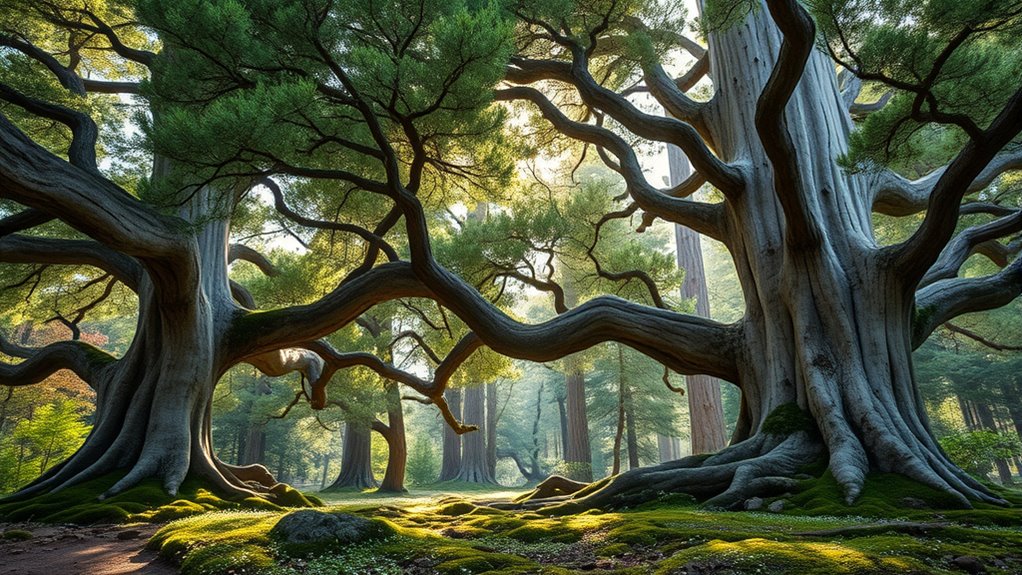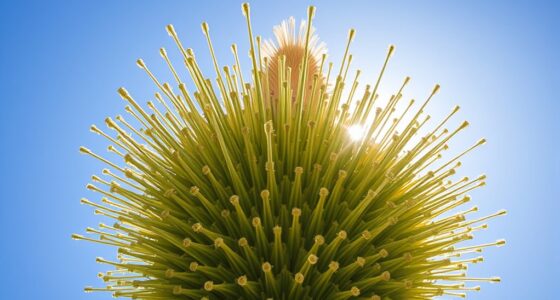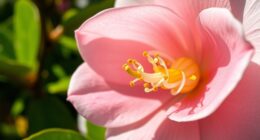The Cedar of Lebanon’s ancient groves stand as symbols of resilience and cultural pride, but they face threats from deforestation, climate change, and pests. Scientists use modern techniques like genetic analysis, seed banking, and soil management to restore and protect these iconic trees. Tech innovations, community efforts, and sustainable practices are crucial for their future. If you keep exploring, you’ll discover how science and tradition come together to safeguard these timeless symbols for generations to come.
Key Takeaways
- Restoration combines ecology, genetics, and modern technology to protect and sustain Lebanon’s ancient cedar groves.
- Genetic diversity analysis guides seed sourcing and replanting efforts for resilient cedar populations.
- Protecting existing groves from deforestation, pests, and climate change is critical for cedar preservation.
- Scientific research and community involvement support sustainable management and education initiatives.
- Advanced techniques like soil conservation, water management, and sustainable practices ensure long-term cedar health.

The Cedar of Lebanon is a majestic evergreen tree renowned for its historical significance, durability, and distinctive scent. As you observe these ancient trees, you can’t help but feel a sense of awe at their resilience, having stood for thousands of years through wars, natural disasters, and changing climates. These trees once formed the backbone of civilizations, used in constructing temples, ships, and palaces, their wood prized for its strength and aromatic qualities. Today, they symbolize endurance and cultural identity for Lebanon and surrounding regions. Yet, despite their hardy reputation, many cedar groves face threats from deforestation, climate change, and pests, putting their future at risk. This is where the science of restoration becomes essential, offering hope and practical solutions for preserving these iconic trees.
When you get involved in restoration efforts, you tap into advanced techniques that combine ecology, forestry, and modern technology. Scientists analyze the genetic diversity of cedar populations to identify the most resilient trees, which then become the seed sources for replanting projects. You might participate in seed collection, ensuring that the genetic pool remains healthy and diverse, or assist in nurturing young saplings in nurseries. These efforts are crucial because cedar trees grow slowly; it can take decades for a sapling to reach maturity. Consequently, patience and careful planning are fundamental components of restoration. You also learn about soil conservation and water management, critical factors in supporting healthy growth amid changing environmental conditions. Restoring cedar forests isn’t just about planting trees; it’s about creating a sustainable ecosystem where these giants can thrive once again.
In climate modeling, you see how researchers predict future scenarios for cedar populations based on different environmental variables. This scientific approach allows you to understand the importance of proactive measures—such as protecting existing groves from logging and controlling invasive species—that can make a significant difference. You realize that restoration is a multi-faceted process involving local communities, governments, and scientists working together. Education plays a key role, too, inspiring people like you to value and protect these ancient trees. By supporting conservation initiatives, you help guarantee the cedar’s legacy endures for generations to come. The science of restoration isn’t a one-time fix; it’s an ongoing commitment to nurturing the resilience of the Cedar of Lebanon and safeguarding its place in history, culture, and the natural world. Incorporating high-efficiency solar panels and modern technology into restoration efforts can further enhance sustainable management practices.
Frequently Asked Questions
What Are the Traditional Cultural Significances of Cedar of Lebanon?
You’ll find that the Cedar of Lebanon holds deep cultural significance, symbolizing strength, resilience, and eternal life. Historically, it represented divine protection and was used in sacred rituals, royal insignia, and temple constructions. In Lebanese identity, it’s a national emblem reflecting pride and heritage. Its enduring presence reminds you of the land’s rich history, inspiring reverence for nature’s enduring power and the importance of preservation for future generations.
How Do Cedar Groves Influence Local Biodiversity and Ecosystems?
Like a guardian of ancient secrets, cedar groves shape local biodiversity and ecosystems profoundly. You’ll find these forests providing habitat for diverse flora and fauna, supporting pollinators, and maintaining soil stability. By acting as ecological anchors, they promote resilience against climate shifts and help sustain water cycles. Your preservation efforts not only protect these majestic trees but also guarantee the vitality of entire ecosystems, safeguarding nature’s delicate balance for future generations.
What Are the Latest Scientific Techniques Used in Cedar Restoration?
You use advanced techniques like drone mapping and LiDAR to assess cedar health and forest structure accurately. Researchers apply genetic analysis to select resilient saplings and employ mycorrhizal inoculation to boost root growth. Additionally, you might incorporate controlled burns and soil restoration practices to prevent invasive species. These methods help guarantee sustainable cedar regeneration, improve forest resilience, and support biodiversity, making restoration efforts more effective and scientifically grounded.
Can Cedar Wood Be Sustainably Harvested Without Harming the Groves?
Yes, you can sustainably harvest cedar wood without harming the groves. By practicing precise pruning, selective cutting, and adhering to strict harvesting schedules, you guarantee the trees’ health and longevity. Implementing innovative techniques like controlled coppicing promotes renewal and resilience. When you prioritize preservation, your actions support the survival of these ancient groves while allowing responsible resource use, confirm future generations can enjoy their majestic majesty.
How Does Climate Change Threaten the Future of Cedar of Lebanon?
Climate change threatens the future of the Cedar of Lebanon by increasing droughts, intensifying storms, and raising temperatures, which stress the trees and disrupt their natural growth. You might notice more pests and diseases, and the altered climate can reduce seed production. To protect these iconic trees, you need to support conservation efforts, reduce your carbon footprint, and advocate for policies that address climate change and preserve their natural habitat.
Conclusion
If you ignore the majestic Cedar of Lebanon, you’re risking the loss of a forest so ancient it holds the secrets of the universe itself. This isn’t just a tree—it’s a living miracle that could vanish forever if we don’t act now. By embracing restoration science, you hold the power to revive a legendary grove that has stood for millennia. Don’t let history’s greatest guardian fade into oblivion—your actions can make history!










